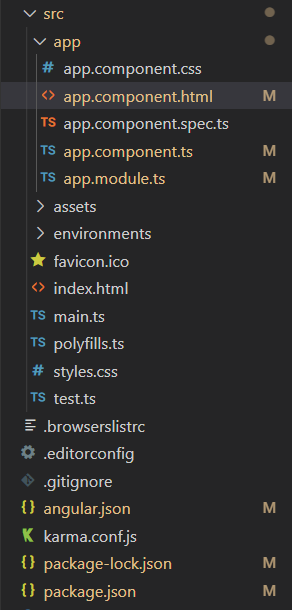Angular PrimeNG Form Rating Events Component
Last Updated :
23 Oct, 2022
Angular PrimeNG is a UI component library for Angular Applications. It offers many pre-built themes and UI components for a variety of tasks like inputs, menus, charts, Buttons, etc. In this article, we will be seeing Angular PrimeNG Form Rating Events Component.
The Form Rating Component is a selection input based on the star icon. It can be usually seen on product pages of e-commerce websites like Amazon, Flipkart, Alibaba, etc. The events of the form rating component are listed below.
Angular PrimeNG Form Rating Events:
- onRate: This event accepts a callback function that is invoked when the rating value is changed.
- onCancel: This event accepts a callback function that is invoked when the rating value is removed.
Angular PrimeNG Form Rating Properties:
- stars: This property specifies the total number of stars in the rating component.
- cancel: This property specifies whether to show a cancel icon to remove the rating.
- disabled: When present, this property disables the rating component.
- readOnly: When present, this property makes the treating read-only i.e it cannot be changed.
- iconOnClass: It is the style class of the icon. The default value is “pi pi-star-fill”.
- iconOffClass: It is the style class of the off icon. The default value is “pi pi-star”.
- iconCancelClass: It is the style class of the cancel icon. The default value is “pi pi-ban”.
- iconOnStyle: It is the inline style of the icon. The default value is null.
- iconOffStyle: It is the inline style of the off icon. The default value is null.
- iconCancelStyle: It is the inline style of the cancel icon. The default value is null.
Syntax:
<p-rating
[stars]="..."
(event-name)="callbackFunction()"
[(ngModel)]="...">
</p-rating>
Creating Angular Application and Installing the Module:
Step 1: Create an Angular application using the following command.
ng new appname
Step 2: After creating your project folder i.e. appname, move to it using the following command.
cd appname
Step 3: Finally, Install PrimeNG in your given directory.
npm install primeng --save
npm install primeicons --save
Project Structure: The project Structure will look like this after following the above steps:

Project Structure
Example 1: This example illustrates the use of the onRate event of the rating component. Whenever the rating value changes a toast is shown with the updated rating value.
app.component.html
HTML
<h2 style="color: green">
GeeksforGeeks
</h2>
<h3>
Angular PrimeNG Form
Rating Events Component
</h3>
<p-rating [stars]="5"
(onRate)="handleOnRate($event)"
[(ngModel)]="rateValue">
</p-rating>
<p-toast></p-toast>
|
app.component.ts
Javascript
import { Component } from '@angular/core';
import { MessageService } from 'primeng/api';
@Component({
selector: 'app-root',
templateUrl: './app.component.html',
styleUrls: ['./app.component.css'],
providers: [MessageService],
})
export class AppComponent {
constructor(private ms: MessageService) { }
rateValue: number = 0;
handleOnRate(ev: any) {
this.ms.add({
severity: 'success',
summary: 'Rating Changed',
detail: 'New Value: ' + ev.value,
});
}
}
|
app.module.ts
Javascript
import { NgModule } from '@angular/core';
import { BrowserModule } from '@angular/platform-browser';
import { BrowserAnimationsModule } from
'@angular/platform-browser/animations';
import { AppComponent } from './app.component';
import { FormsModule } from '@angular/forms';
import { ToastModule } from 'primeng/toast';
import { RatingModule } from 'primeng/rating';
@NgModule({
imports: [
BrowserModule,
BrowserAnimationsModule,
RatingModule,
ToastModule,
FormsModule,
],
declarations: [AppComponent],
bootstrap: [AppComponent],
})
export class AppModule { }
|
Output:
Example 2: In this example, we used the onCancel event of the Rating component provided by Angular PrimeNG to show a toast message whenever the rating is removed.
app.component.html
HTML
<h2 style="color: green">
GeeksforGeeks
</h2>
<h3>
Angular PrimeNG Form
Rating Events Component
</h3>
<p-rating [stars]="5"
(onCancel)="handleOnCancel()"
[(ngModel)]="rateValue">
</p-rating>
<p-toast></p-toast>
|
app.component.ts
Javascript
import { Component } from '@angular/core';
import { MessageService } from 'primeng/api';
@Component({
selector: 'app-root',
templateUrl: './app.component.html',
styleUrls: ['./app.component.css'],
providers: [MessageService],
})
export class AppComponent {
constructor(private ms: MessageService) { }
rateValue: number = 0;
handleOnCancel() {
this.ms.add({
severity: 'error',
summary: 'Rating Removed',
detail: 'onCancel Event Triggered',
});
}
}
|
app.module.ts
Javascript
import { NgModule } from '@angular/core';
import { BrowserModule } from '@angular/platform-browser';
import { BrowserAnimationsModule } from
'@angular/platform-browser/animations';
import { AppComponent } from './app.component';
import { FormsModule } from '@angular/forms';
import { ToastModule } from 'primeng/toast';
import { RatingModule } from 'primeng/rating';
@NgModule({
imports: [
BrowserModule,
BrowserAnimationsModule,
RatingModule,
ToastModule,
FormsModule,
],
declarations: [AppComponent],
bootstrap: [AppComponent],
})
export class AppModule { }
|
Output:
Reference: http://primefaces.org/primeng/rating
Like Article
Suggest improvement
Share your thoughts in the comments
Please Login to comment...